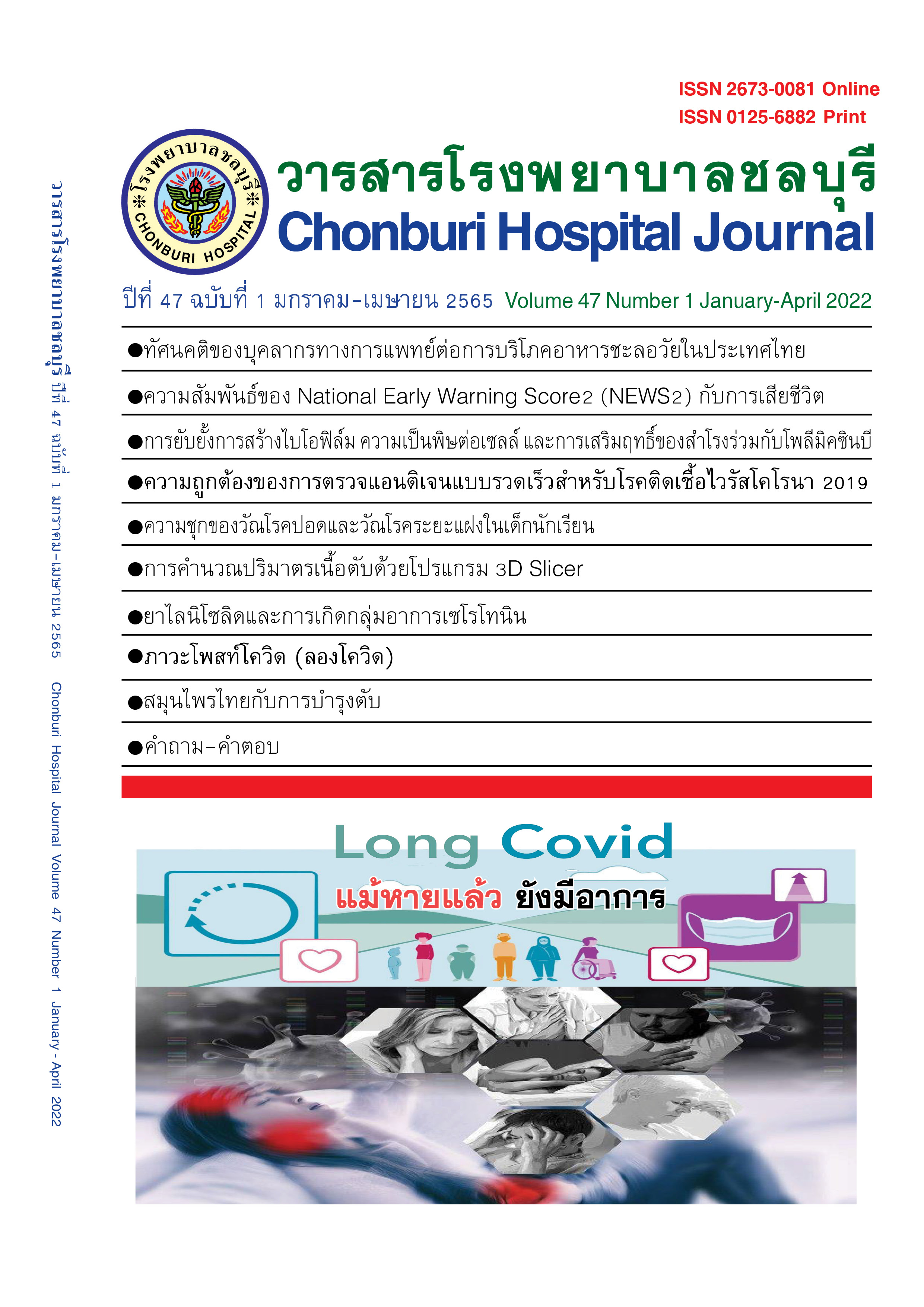The Healthcare Professionals' Attitudes Toward Anti-aging Food Consumption for Treatment in Thailand
Abstract
The human body's deterioration is a consistent change throughout a person's life. Aging derives from multifactorial causes. Studies have shown that free radicals can damage cells and tissues. Such damage leads to a state of deterioration of the body. A decent controlled diet can help reduce the deterioration of the body's performance. The objectives of this research were to study the influence of the health consciousness, perceived health risk, perceived usefulness, attitude toward behavioral, and perceived behavioral control of the healthcare professional on the consumption of anti-aging food. The results showed that health consciousness, perceived health risk, perceived usefulness, and attitude toward behavior positively influenced the perception of the professional healthcare in providing anti-aging dietary advice to control food consumption behavior to recipients. Healthcare professionals who have self-confidence in advising on an anti-aging diet will confidently educate the recipients to follow their advice. According to the advice, the recipients can adopt their dietary habits to abate aging more effectively. In addition, this research will contribute to the body of knowledge of anti-aging diet science for developing healthcare professionals.
References
Gladyshev VN. Aging: progressive decline in fitness due to the rising deleteriome adjusted by genetic environmental, and stochastic processes. Aging Cell 2016;15(4):594–602.
Raty JV, Zhang W, Luckas J, Chen C, Mazzarello R, Bichara C, Wuttig M. Aging mechanisms in amorphous phase-change materials. Natural Communication 2015;6:7467.
Olivieri F, Albertini MC, Orciani M, Ceka A, Cricca M, Procopio AD, et al. DNA damage response (DDR) and senescence: shuttled inflamma-miRNAs on the stage of inflamm-aging. Oncotarget 2015;6(34):35509-21.
Kehrer JP, Klotz L. Free radicals and related reactive species as mediators of tissue injury and disease: implications for health. Critical Reviews in Toxicology 2015;45(9):765-98.
López-Otín C, Blasco MA, Partridge L, Serrano M, Kroemer G. The hallmarks of aging. Cell 2013;153(6):1194-217.
Su J, Ekman C, Oskolkov N, Lahti L, Ström K, Brazma A, et al. A novel atlas of gene expression in human skeletal muscle reveals molecular changes associated with aging. Skeletal Muscle 2015;5(35):1-12.
Chung HY, Sung B, Jung KJ, Zou Y, Yu BP. The molecular inflammatory process in aging. Antioxid Redox Signal 2006;8(3-4):572-81.
Masoro EJ. Caloric restriction and aging: an update. Exp Gerontol 2000;35(3):299-305.
Kumari S. Black rice: an emerging "superfood." Pantnagar Journal of Research 2020;18(1):15-8.
Yang Y, Ren C, Zhang Y, Wu X. Ginseng: an nonnegligible natural remedy for healthy aging. Aging Dis 2017;8(6):708-20.
Mastaloudis A, Wood SM. Age-related changes in cellular protection, purification, and inflammation-related gene expression: role of dietary phytonutrients. Ann N Y Acad Sci 2012;1259:112-20.
Salter A, Wiseman H, Tucker G. Phytonutrients. West Sussex: Wiley-Blackwell; 2012.
Tapsell LC, Neale EP, Satija A, Hu FB. Foods, nutrients, and dietary patterns: interconnections and implications for dietary guidelines. Adv Nutr 2016;7(3):445-54.
Bergmann BM, Gilliland MA, Feng PF, Russell DR, Shaw P, Wright M, Rechtschaffen A, Alverdy JC. Are physiological effects of sleep deprivation in the rat mediated by bacterial invasion? Sleep 1996;19(7):554-62.
Chein I, Cook SW, Harding J. The field of action research. American Psychologist 1948; 3(2):43–50.
Krech D, Crutchfield RS, Ballachey EL. Individual in society: a textbook of social psychology. NY: McGraw-Hill; 1962.
Schiffman LG, Kanuk L. Consumer behavior. NJ: Englewood Cliffs; 1994.
Gould SJ. Consumer attitudes toward health and health care: a differential perspective. Journal of Consumer Affairs 1988;22:96–118.
Newsom JT, McFarland BH, Kaplan MS, Huguet N, Zani B. The health consciousness myth: implications of the near independence of major health behaviours in the North American population. Social Science and Medicine 2005;60:433–37.
Phipps DJ, Hagger MS, Hamilton K. Predicting limiting 'free sugar' consumption using an integrated model of health behavior. Appetite 2020;150:104668.
Ajzen I. The theory of planned behavior. Organizational behavior and human decision processes 1991;50(2):179-211.
Moslehpour M, Pham VK, Wong WK, Bilgiçli İ. E-purchase intention of Taiwanese consumers: sustainable mediation of perceived usefulness and perceived ease of use. Sustainability 2018;10(1):234.
Phusiri P, Somjai S, Sriwatanaku K. Perceived usefulness, perceived risk, perceived ease of use and attitude affecting on consumer acceptance in stem cell technology in anti aging medicine. Journal of the Association of Researchers 2019;24(3):57-73.
Downloads
Published
Issue
Section
License

This work is licensed under a Creative Commons Attribution-NonCommercial-NoDerivatives 4.0 International License.
บทความที่ได้รับการตีพิมพิ์เป็นลิขสิทธิ์ของวารสารโรงพยาบาลชลบุรี
